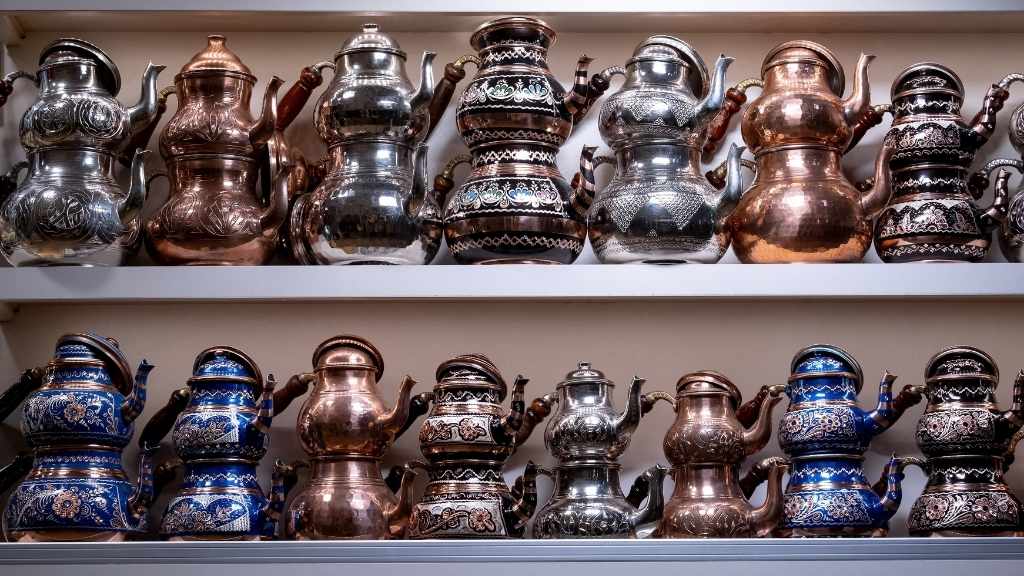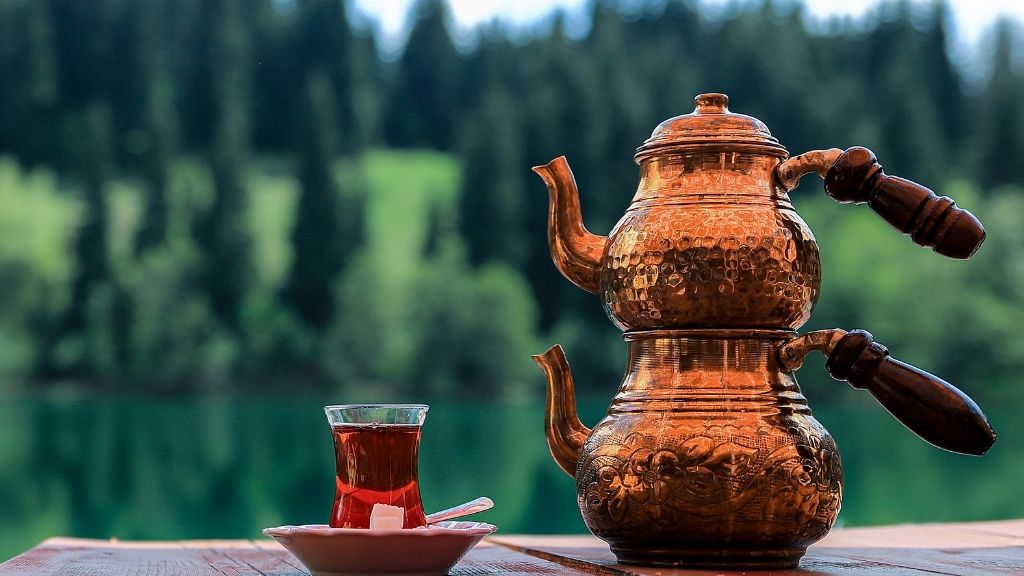Turkish tea leaves a lasting impact; there is a reason behind that, and it is not just about the quality of the leaves, but also the effort invested in the brewing process. Whether in the vibrant tea houses of Istanbul or a quiet countryside kitchen, preparing tea with a çaydanlık is more than a method — it’s a social and cultural tradition. The famous double teapot allows you to adjust the strength and taste, which cannot be compared to a tea bag.
In this guide, you’ll learn exactly how to make Turkish tea like a local, using the proper ratios, time-tested brewing tips, and simplified methods. My first experience with the double teapot was a bit nervous and a bit uncertain, but when I swigged that first cup, I never looked back. If you have ever wished to feel the heat of a real Turkish morning, you are at the right place.
Brewing in Istanbul
During my stay at a cozy guesthouse tucked away in the old streets of Istanbul, every morning began with the inviting aroma of Turkish tea slowly brewing in a çaydanlık — the classic double teapot. It would be served by the host with warm simit and olives, such a simple but so traditional spread. It was one morning in the courtyard when the sweet-sounding clinking of tea glasses could be heard. I observed her pouring strong tea on top of the teapot and balancing it with a bit of hot water at the bottom of the teapot. The resultant flavor was rich, smooth, and earthy, a lesson that some of the best flavors in life can be found by taking things slowly.
Understanding Turkish Tea Culture
Tea as a Daily Ritual in Turkish Life
In Turkey, tea or çay is far more than just a beverage; it’s a daily ritual and a symbol of hospitality woven into the country’s social fabric. To understand the deeper meaning behind this tradition, explore our article on why Turkish tea culture runs deep in daily life. You can be sitting in a bazaar, in somebody’s home, or in a shop waiting. Still, you will hardly be able to escape Turkish Black Tea, known not just for its taste but also for its cultural significance and potential health benefits. There is no habit in most people to drink 3 to 5 cups a day, but it is a means of stopping, bonding, and sharing.
👉 If you’ve ever wondered whether drinking several cups a day is actually healthy, check out our complete guide on Turkish tea safety and side effects.
What “Çay” Really Is
What makes çay distinct starts with its origin. It is (almost always) black loose-leaf tea cultivated in the rich, rain-drenched slopes of the Rize area of the Black Sea. Unlike the English tradition, Turkish tea is served strong and clear – never with milk – and poured into small tulip-shaped glasses called ince belli, which let you appreciate both its deep color and warmth in hand.
Brewing Method: The Art of Slow Extraction
Among the most important aspects that make Turkish Tea stand out from other black teas is its procedure of brewing. Instead of steeping it quickly like many Western teas, Turkish tea is slowly brewed using two stacked kettles – the çaydanlık. This low simmering helps to coax out all the flavor to produce a beverage that is strong yet gentle and rich with natural fragrance. It is not a matter of speed but a matter of taking time both in the process of making and in the consumption – another way tea stands apart from coffee in taste, ritual, and daily life.
Essential Equipment for Making Turkish Tea
What Is a Çaydanlık (Double Teapot)?
The heart of authentic Turkish tea preparation is the çaydanlık, a double teapot made of two stacked kettles. The bottom kettle is utilized to boil the water, and the top one is utilized to put the loose-leaf tea and a little bit of hot water to steep. This two-tier system enables the tea to brew without direct heat and hence retains all its flavor and aroma.

Traditional Turkish çaydanlık teapots on display.
Step-by-Step: How to Use a Çaydanlık
- Boil Water in the Bottom Kettle: First, fill the bottom kettle with fresh water and boil it. Such hot water will be used to steep the tea and also dilute it later.
- Put Loose Tea into Top Kettle: Put in the upper kettle approximately 1 teaspoon of black loose-leaf tea per cup. Put some of the boiling water from the bottom kettle over the leaves to start brewing.
- Simmer Gently: Put both kettles on low heat and simmer together for 15 to 20 minutes. The low-and-slow approach is what makes Turkish tea so recognizable by its dark color and complex taste.
- Serve with Moderation: Serve by pouring a little strong tea from the upper kettle into a tulip-shaped glass and diluting it to your own strength with the hot water in the lower kettle.
Why Double Teapots Make a Difference
The çaydanlık gives you full control over how strong or mild your tea turns out. It also keeps the water hot for hours, which translates to fresh cups all through the day. The double teapot configuration captures more of the aroma and taste compared to the one-pot technique. Thus, each drink is more delightful.
Best Alternatives When You Don’t Have a Çaydanlık
Can’t find a çaydanlık? These are some of the imaginative and feasible ways out:
- Saucepans: Two saucepans, the lower one to boil the water and the upper one to steep the tea leaves.
- French Press: Put the black loose-leaf tea in a French press and steep, then add some hot water to taste.
- Electric Samovars or Tea Makers: Contemporary electric tea makers, such as Turkish-style samovars, are perfect in order to keep the water hot and recreate the experience of the traditional brewing method.
Supporting Tools That Elevate the Experience
- Fine Mesh Strainer: It helps in sieving tea leaves in the process of pouring them into the glass.
- Tulip-Shaped Glasses (Ince Belli): These old-fashioned glasses are more beautiful and assist in keeping the proper temperature and smell.
- Samovar on the table: Samovar, which is originally Russian but commonly seen in Turkish households, is the way to go when it comes to serving groups of people while keeping that slow-brewed richness.
Step-by-Step Guide: How to Make Turkish Tea
Preparation of Turkish tea is an exercise of precision, patience, and control, and it begins with the correct tea-to-water ratio. It is a standard ratio of 1 teaspoon of loose-leaf tea to 100 ml of water, though you may adjust it to your taste. To make a light cup, add more water and fewer tea leaves. Do the reverse, more tea, less water, in case you want it strong (demli çay). The çaydanlık technique is beautiful because you can easily adjust the strength of the cup.
Use Fresh Water and Watch the Heat
Fresh, cold water is one of the golden rules in brewing Turkish tea; never reboil water. Place the bottom kettle on the rolling boil, then pour only the required amount of water into the upper kettle to cover the tea leaves. This upper pot must not boil; it must be placed above a gentle heat to permit slow steeping without burning the tea.
Mastering the Steeping Process
When the tea is in the upper pot, it should sit over low heat for 15 to 20 minutes. No need to stir or hurry it up – the gradual steeping time gives the tea a chance to acquire its typical aroma, color, and rich flavor. It is the phase where patience works. The hasty brew will be bitter, not the smooth and layered flavor that Turkish tea is famous for.
Serving Turkish Tea the Traditional Way
Turkish tea is a kind of art of serving. The right way to do it is like this:
- Pour Strong Tea into the Top Pot: Pour the strongly brewed tea into the top pot into one-third to half of a tulip-shaped glass.
- Add Hot Water from the Bottom Kettle: Add hot water to taste to make it light, medium, or strong.
- Serve with a Sugar Cube (Optional): Traditional tea is not served with any milk but with a sugar cube to the side for those who have a sweet tooth.

Variations: Modern & Minimalist Brewing
In today’s kitchens, many people have started using electric çaydanlık teapots, especially in Turkish homes where convenience blends with tradition. These new appliances also use the same principle of the double-kettle but automate the boiling and steeping. Although they reduce manual labor, the traditional character of Turkish tea brewing, which is strong, layered, and highly aromatic, is maintained.
Refreshing Variations: For a fruitier take on tradition, try Turkish Apple Tea – naturally sweet, refreshing, and easy to make with simple fruit infusion methods. Craving something cooler for summer? Don’t miss our step by step guide on How to Make Turkish Iced Tea – a bold, chilled twist on the classic.
One-Pot vs Two-Pot Brewing: What’s the Difference?
Here’s a quick comparison between using a single pot and the traditional two-pot çaydanlık system:
- Flavor: The single-pot will provide a less intense brew, whereas the two-pot system will produce that thick and full-bodied flavor.
- Control Over Strength: With a çaydanlık, you can easily adjust your tea strength to suit each person’s taste. The one-pot technique is much less versatile.
- Cultural Authenticity: The use of two pots to brew is authentic to the Turkish experience and tradition. One pot can be quick, but there is no ritualistic sense.
Easy Brewing Tips for Travelers
You can also enjoy a good cup of Turkish tea even when traveling, camping, or staying in a small space without needing the entire set. These are some easy tools and hints that can make it possible:
- Foldable Silicone Kettle: A silicone kettle is light, takes up little space, and can be folded. It’s ideal when you need to boil water quickly while on the go.
- Loose Tea Filters for Steeping: Carry some loose tea filters. These are simply like the top pot of a çaydanlk, where the tea leaves can be steeped correctly.
- Thermos for Hot Water: Use a thermos to store hot water. This helps you mix and dilute your strong tea afterward, as is done in traditional serving.
- Quick-Brew Rize Tea Blends: Choose fast-brewing Rize blends. They’re easy to prepare and still provide a rich, good taste when you’re short on time.
Common Mistakes to Avoid When Brewing Turkish Tea
1. Boiling the Tea Instead of Letting It Steep
One could make the mistake of boiling the tea and not the water. The Turkish tea is made by boiling only water. The leaves of tea are to be steeped gradually in hot water. The tea gets bitter and harsh when boiled. To achieve a smooth and rich flavor, take time and let it steep lightly.
2. Using the Wrong Type of Tea
Turkish tea does not pair well with any other type of tea. Do not use tea bags or flavored teas. They lack a rich smell and strong flavor. The most preferable is pure, loose-leaf black tea, such as that of Rize. This tea is specifically prepared for use in Turkish-style brewing, yielding the best results.
3. Stirring the Tea or Not Rinsing the Glass
When the tea is being steeped, do not stir it up. This may upset the tea and cause it to taste bad. It is also never advisable to pour hot tea into a cold glass. Wash your tulip glass always with hot water. It keeps the tea warm and also assists in making the tea release a full aroma.
💡Pro Tips from Turkish Grandmothers
- Heat the Glass First: Rinse your tea glass with some hot water so that your tea will stay warm.
- Slowly Steep Tea: Take time to steep the tea. It releases a creamy and rich taste.
- Tea in Turkey is served with a kind heart: The tea is served in Turkey with care. The tea is served even better with a calm atmosphere and a welcoming gesture.
Mine Insights
According to me, as a Turkish Tea lover and Cultural writer,
“True Turkish tea is brewed with intention. It’s not just about the caffeine – it’s about creating connection.”
This simple tradition isn’t rushed or mechanical; it’s a quiet, meaningful ritual that brings people closer, one steeped cup at a time.
FAQs About Brewing Turkish Tea
What Kind of Tea Leaves Are Used?
Turkish tea is prepared with black tea plants of the Camellia sinensis, which are primarily cultivated in the Rize region of the Black Sea. Brands with which many people are familiar and trust, such as Çaykur, offer authentic loose-leaf varieties that impart the strong flavor and deep color for which Turkish tea is renowned.
Is Sugar Added During Brewing or After?
No sugar is ever added during brewing. Conventionally, a cube of sugar is placed on the side, allowing everyone to sweeten their tea to taste. This preserves the rich, dark taste of the tea and makes it customizable.
Can Turkish Tea Be Made with Green Tea?
Not in the olden-day manner. Green tea fails to achieve the full-bodied aroma and strong flavor that Turkish tea typically requires. But there are modern twists to it. However, they will not provide the same taste or experience.
How Long Should Turkish Tea Steep?
The ideal steeping time is 15 to 20 minutes in the top pot of a çaydanlık. Keep the heat low and refrain from stirring the tea during this time. This slow-brewing method allows the tea to develop its deep color and smooth taste without bitterness.
Final Thoughts
Preparing Turkish tea is not merely the process of boiling water and adding loose-leaf tea to it; it is a restful process that unites people. Whether you’re using a traditional çaydanlık or a modern electric kettle, the real magic is in the slow steeping, the warm aroma, and the care poured into every glass.
This tea has something greater than taste; it has tradition, memory, and connection. So next time you brew, do it with heart — and don’t forget to share your experience with us.

Hi, I’m the heart behind Turkish Aura. I lived in Turkey for 10 beautiful years, where I fell in love with its tea, traditions, and soulful way of life. This blog is my way of sharing real stories, cultural wisdom, and personal experiences to help you feel the true essence of Turkish culture – just like I did.Thank you for being here, and love you!



